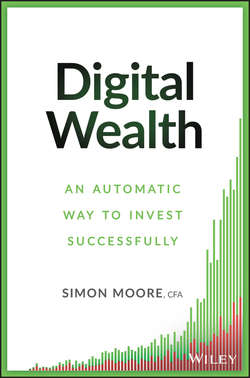Digital Wealth

Реклама. ООО «ЛитРес», ИНН: 7719571260.
Оглавление
Moore Simon. Digital Wealth
Preface
Acknowledgments
Chapter 1. America’s Savings Challenge
We Don’t Save Enough
The Key Change in America’s Retirement Planning Process
How Financial Innovation Helps
The Magic of a 15 Percent Savings Rate
Chapter 2. The Risk of Not Investing in Stocks
The Short-Term Risks
The Historical Perspective
The Logic
Chapter 3. The Enemies of a Stock Portfolio
Why Inflation Matters
Treasury Inflation-Protected Securities (TIPS)
Asset Confiscation
Recession
Chapter 4. The Value of Time for Investors
Why Long-Term Stock Investing Is Less Risky than It May Seem
The Long-Term Picture
How Bonds Can Help
Chapter 5. Core Assets of a Robust Portfolio
Asset Classes We Include
Individual Asset Classes We Exclude
Chapter 6. Dynamic Asset Selection: Determining the Lowest-Cost Option for Each Portfolio
Chapter 7. What Software Does Better than People
How Software Helps Investors
Example: All the Decisions an Algorithm Makes
Chapter 8. How International Investing Can Smooth Returns
Demographics Matter
Diversification Improves Your Industry Mix
Chapter 9. The Advantages of Exchange-Traded Funds
The Benefits of ETFs
In-Kind Transfers
The Risks of ETFs
Securities Lending Policies
Chapter 10. The Triumph of Low-Cost Investing: How Paying Less Gets You More
Fooled by Randomness
A Triumph of Marketing over Results
Chapter 11. Learning from Nobel Prize Winners
Milton Friedman, 1976
James Tobin, 1981
Harry Markowitz, 1990
William Sharpe, 1990
Daniel Kahnemann, 2002
Eugene Fama and Robert Shiller, 2013
Chapter 12. The Costs of Being Active
The Cost of Closet Indexing
The Other Costs of Active Management
Chapter 13. The Greatest Mistakes Made by Novice Investors
Starting Saving Too Late
Are You Using Tax Shelters Effectively?
Are You Taking Advantage of 401(k) Matching If Available?
Are You Diversified Internationally?
Are You Chasing Returns?
Are You Overpaying in Fees?
Are You Tracking the Right Index?
Do You Trade Too Much?
Chapter 14. Tilts and Other Ways to Help Long-Term Performance
History of Market Thought
Data Mining
Debunking Strong-Form Market Efficiency
Rationality
The January Effect
Sell in May and Go Away
Momentum
Value
Small Cap
Quality
Longer-Term Mean Reversion
Assessing Tilts in a Portfolio Context
Chapter 15. Establishing a Tax-Efficient Portfolio
Tax Shelters
Tax Efficiency for Retirement
Tax Efficiency for College
Tax Efficiency for Giving
Tax-Efficient Asset Placement
Tax Loss Harvesting
Offsetting Gains with Losses
The Principal of Tax Deferral
How Tax Loss Harvesting Works
Challenges of Implementing Tax Loss Harvesting
Conclusion
Chapter 16. The Value of Rebalancing and Glidepaths
Rebalancing Keeps a Portfolio on Course
Tiered Rebalancing
Glidepaths
Chapter 17. How to Manage a Market Crash
Keep Stock Market Investing for Longer-Term Money
Making Saving an Ongoing Activity
Pay Attention to Extremes of Long-Term Valuation Signals
Don’t Consider Stocks in Isolation
Remember that You May Underestimate Your Risk Tolerance in Good Markets
Chapter 18. Your Own Worst Enemy Is in the Mirror
The Biggest Threat to Your Returns Is in the Mirror
Always a Reason to Avoid Staying Out
The Returns You See Aren’t the Ones You Get after Tax
The Media Isn’t Your Friend
Overtrading
Home Bias
Failing to Take a Long-Term Perspective
Availability Bias
Chasing Performance
Ignoring Fees
Holding Too Much Cash
How Software Can Help
Chapter 19. Saving for Goals beyond Retirement
Tax Efficiency
Portfolio Construction
Emergency Funds
Investment Flow Chart
Chapter 20. A History of Diversified Portfolio Performance
Stocks vs. Bonds
The Impact of Recessions
The Impact of Inflation
The Danger of Averages
The Benefits of Combination
An Emerging Market that Has Emerged
Chapter 21. The Future of Wealth Management
Lower Costs
Democratization of Services
Increasing Customer Intimacy
Improved Financial Awareness
Chapter 22. Conclusion
Author's Disclaimer
About the Author
Index
WILEY END USER LICENSE AGREEMENT
Отрывок из книги
In 1989, three separate global events heralded a revolution in household investing, with the potential to save American households billions over the coming decades.
In 1989, researchers from Carnegie Mellon University’s ChipTest project joined forces with IBM. Their computer was renamed Deep Blue after a naming contest. This chess computer would ultimately defeat the world champion. The same principles of deep analysis and simulation across multiple scenarios are employed by investment algorithms. The technology that beat the world champion once required a room of computing power. Today, as a sign of the incredible improvements in processing power, that same software no longer requires its own room and can run on a basic consumer phone.
.....
However, we should remember that even the smartest techniques and lowest fees cannot solve the savings rate problem. Prospective returns can be improved but there is no magic wand. With a 6 percent rate of annual growth, you can double your money in 12 years, but if you save nothing, you’ll still end up with nothing at the end. That’s true however long you have to save and however well balanced a portfolio is on offer.
And, unfortunately, the savings challenge is getting harder, not easier. The global increase in life expectancy is a good thing, but it puts a lot more pressure on your retirement dollars that now have to last years longer than previously. Retirement actually is a relatively new phenomenon. Previously, people would quite literally work until they died. At the end of the Second World War, the average life expectancy of an American at birth was 65, meaning that many would have no retirement at all. Now, for those born in 2010, it is just over 78.6 That is an increase of 13 years over two generations, and so retirement moves from being a short period to something most people can plan on experiencing for a decade or longer. The moves for an increased retirement age are unsurprising in the context of this stark improvement in life expectancy and quality of life for the elderly. Figure 1.2 shows U.S. life expectancy at age 65 over time, and the trend of increasing life expectancy is clear: this puts a greater burden on retirement savings as the retirement period lengthens.
.....